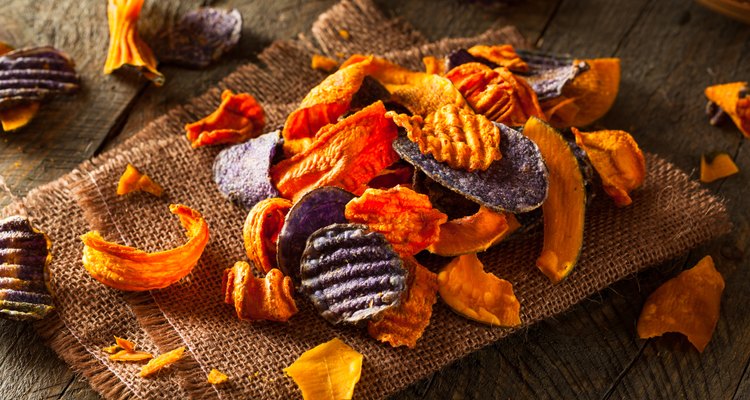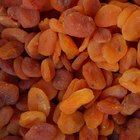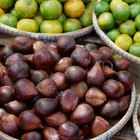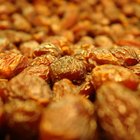
bhofack2/iStock/Getty Images
In the modern age of widespread refrigeration, drying foods for preservation is no longer a life-or-death issue. However, drying vegetables is still a practical preservation option. Drying leaves your vegetables very light and compact, requiring much less space than other preservation methods. Drying removes much of the vitamin C from vegetables, but their fiber remains and the vegetables will retain useful quantities of most other vitamins and minerals. When dried to crisp chips, the vegetables can be reconstituted for cooking or simply eaten as a snack.
Choosing Your Vegetables
To make the best-quality dried vegetables, start with the best-quality fresh vegetables. Choose firm, unblemished specimens without any soft spots, mold, bruising or visible insect damage. For vegetable chips, use vegetables with a firm texture that can be cut into consistently thin slices. Carrots, parsnips, turnips or rutabagas, winter squash and peeled bell peppers are all suitable choices.
Preparation
Start with freshly washed hands and clean, sanitized utensils and work surfaces. Wash the vegetables carefully, then peel them if appropriate. Cut them into uniform slices, 1/4 inch or thinner. A flat mandoline slicer can help make your slices consistent, but a sharp knife or even a vegetable peeler will work. For bell peppers, char and remove the skin and cut the flesh into strips. In each case, the thinner the slices the crisper the finished chips will be.
Blanching and Antioxidants
Before drying the vegetables, there are two methods you can use to improve the quality of your finished product. One is to soak your strips of vegetables in water made acidic with lemon juice or ascorbic acid -- vitamin C -- which will prevent oxidation. The second method is to blanch your vegetables in boiling water for 30 seconds to two minutes, depending on the vegetable, then chill them rapidly in ice water. Both methods help preserve the vegetables' flavor and nutrition, and provide a degree of protection against foodborne illness by killing bacteria and molds.
Drying
Carefully blot your vegetable slices dry on clean paper towels. Arrange them on the dehydrator's trays in a single layer, leaving space for air to circulate. Dry the vegetables at 140 degrees Fahrenheit until they're fully dried and crisp, about three to five hours depending how thinly they're sliced. Turn them periodically to ensure the most even drying possible. When finished, turn off the dehydrator and allow the heat to dissipate, then leave the vegetables to cool.
Storage and Use
Crisp, brittle vegetable chips can be packaged for storage as soon as they're cool. Pack them carefully into airtight plastic bags, ideally using a vacuum sealer. The more airtight the package, the better your storage life. Keep the vegetables in a cool, dark place for six months to a year, opening and using them as needed. To eat the vegetable chips as a snack, distribute them on a parchment-lined baking sheet and recrisp them at the lowest possible temperature. They can be chopped, crumbled or reconstituted for use in baking or cooking.
Related Articles

How to Preserve Rutabagas

How to Blanch Cucumbers

How to Dry Radishes

How to Deep Fry Vegetables With Batters

How to Freeze Carrots & Turnips

Can Dried Fruit Be Frozen?

How to Store Hot Peppers

How to Oven-Dry Figs
How Long Does It Take to Dry Apples in ...

How to Cook Zucchini Like a Japanese ...

How to Freeze Pole Beans
Can We Refreeze Frozen Vegetables?

How to Wash Wax Off of Vegetables

How to Dry Wild Morel Mushrooms

How to Cook Vegetables in the Microwave

Tips for Cooking with Dehydrated ...

How To Wash T-Shirts So They Won't ...

How to Refresh Dried Fruits: Raisins

How to Smoke Fruit to Preserve It

How to Dry Cilantro at Home
References
- On Food and Cooking: The Science and Lore of the Kitchen; Harold McGee
- Colorado State University Cooperative Extension: Drying Vegetables
Writer Bio
Fred Decker is a trained chef and prolific freelance writer. In previous careers, he sold insurance and mutual funds, and was a longtime retailer. He was educated at Memorial University of Newfoundland and the Northern Alberta Institute of Technology. His articles have appeared on numerous home and garden sites including GoneOutdoors, TheNest and eHow.
Photo Credits
bhofack2/iStock/Getty Images